Amenti review
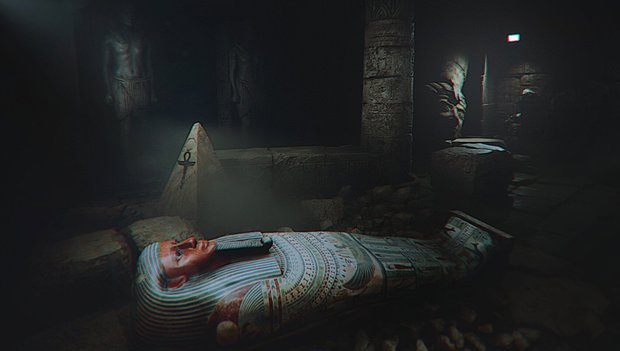
- 0 Comments
Puzzles, scares, and a few ancient gameplay curses unearthed in this short but solid Egyptian tomb thriller
Ancient Egypt has been the subject of countless books, movies, documentaries, and video games. Its awe-inspiring monuments—such as the pyramids, great temples, and subterranean tombs—its unimaginable treasures, and its complex mythology, have lured scholars and storytellers to explore its mysteries for almost three centuries. Amenti, an exploration/horror game by DarkPhobia Games, tells the story of one such explorer, offering a short yet enjoyable and occasionally not-too-scary journey through time and mysteries.
The game’s title is one of the names of the goddess also known as Imentet. She is a relatively minor Egyptian deity, a guardian of the deceased and the underworld. She was tasked with welcoming the dead to the afterlife and supplying them with food and drink for their long journey to paradise. The term “Amenti” also refers to the place where the sun sets and marks the gateway to the underworld. This subtle detail may offer a hint of the challenges and revelations that await as the game unfolds.
Ethan Carter (no apparent relation to The Astronauts’ missing child in The Vanishing of Ethan Carter), a professional photographer with a zest for obscure and forbidden locations, sets out to illegally enter an archeological dig site and photograph the tomb of Pharaoh Rudamon, who ruled Egypt in the 8th century BC. The problem is that this tomb, located just around the corner from the Great Pyramid of Giza, is said to be cursed. Unbeknownst to him at first, Carter is following in the footsteps of Henry Caldwell, a renowned historian who disappeared at this very location about fifty years earlier.
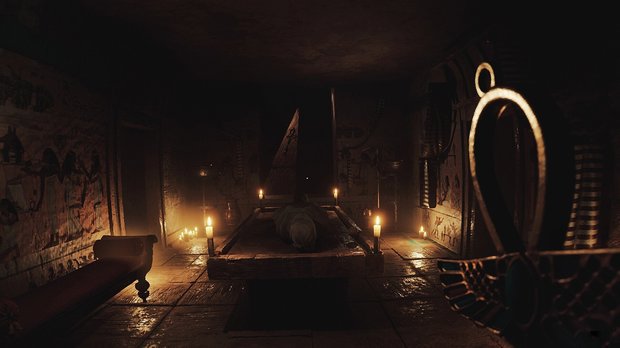
As he ventures deeper into the tomb, Carter is inexplicably thrust between different realities when the ancient curse manifests itself in sinister ways. There are supernatural forces at work: They suddenly transport Carter between ancient and modern times, they make statues move, cause ghostly apparitions to appear unexpectedly, and make blood-curdling shrieks and moans echo through the chambers. It feels as if the tomb is brimming with otherworldly beings that do not wish to be disturbed. There are some creepy jump scares – anticipated as they were, given the nature of the game, there were some cleverly hidden ones that made me catch my breath – but there’s no gore and the overall atmosphere is eerie, emphasizing psychological horror over real danger.
Amenti is presented in full 3D, first-person view. Movement can be controlled with either a gamepad or keyboard—the latter utilizing the familiar WASD keys, along with others for specific actions like crouching, jumping, and rotating objects. Mouse buttons are used to interact with objects and take pictures. Overall, movement feels smooth and fluid, and Ethan's walking speed is not too fast and not too slow. You can also run, using the left SHIFT key, a feature that becomes useful in latter stages of the game.
The plot is thin, loosely tying together ancient and modern history, mythology, and conspiracy theories. The premise is reminiscent of an Indiana Jones movie: get into the tomb, get what you want, and get out—preferably alive. The game does not elaborate much beyond that. At the beginning, you arrive at the archaeological site with only a vague idea of how to enter the tomb and what exactly you are looking for, but the game subtly guides you along. The focus here is clearly on exploration rather than backstory or character development. These elements would have been welcome, but the experience is quite short (one to two hours), so their absence isn’t too deeply felt.
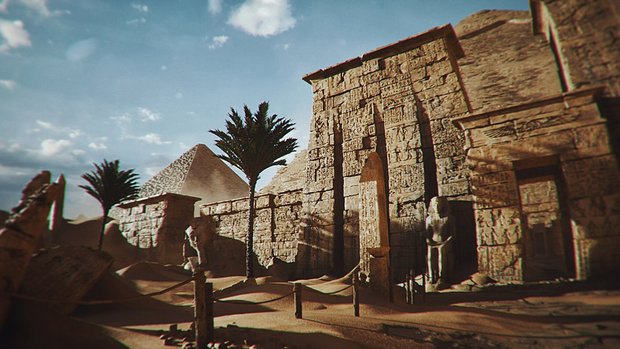
Graphically, Amenti is a fusion of historical authenticity and artistic precision. When Carter finds himself visiting the past, the walls are covered with finely detailed hieroglyphs and colourful murals, ritualistic vessels are scattered throughout dimly lit corridors, and golden artifacts and decorated sarcophagi lie buried in the shadows. Everything is rendered in rich, vibrant colours. When Carter is in the present, the same environments are still intricately detailed but appear crumbling and decayed in the dark, with worn hieroglyphs and cracked stone surfaces illuminated only by the night sky and Carter’s torch. It all adds up to a richly atmospheric experience that draws you deep into the tomb’s mysteries.
The overall mood is further enhanced by the soundtrack—subtle and evocative. More felt than heard, the score lends a gloomy touch to the exploration. For most of the game, the music remains abstract, delicately blending occasional Arabic motifs. As for voice acting, there is almost none apart from the ending. Carter’s thoughts are presented only through subtitles. At first this felt like a design weakness, but then it made sense: when people are alone, especially in a dark and ancient tomb, they don’t usually speak aloud to themselves.
Puzzles are well integrated into this game world, feeling natural in the environment without artificially padding the gameplay. There is some backtracking and item-fetching, but most puzzles are solved on-site. They comprise mostly opening sarcophagi, finding your way through or around secret doors and passages, and obtaining ancient relics to be used elsewhere. There are some simple mechanical puzzles and one big tile puzzle but none of them are too complicated. Clues are usually nearby and can be uncovered through careful observation and clever use of the camera.
Carter’s camera is not only for taking pretty pictures. You can, and should, use it to reveal hidden clues, uncover some of the supernatural forces, and – at least on one occasion – initiate a sequence that is crucial for continuing in the game. It is the camera flash that triggers events. Whether to make a mummy vanish, startle a lurking creature, or imprint crucial information on a wall, the sudden burst of light is crucial to your success but not welcomed around these parts.
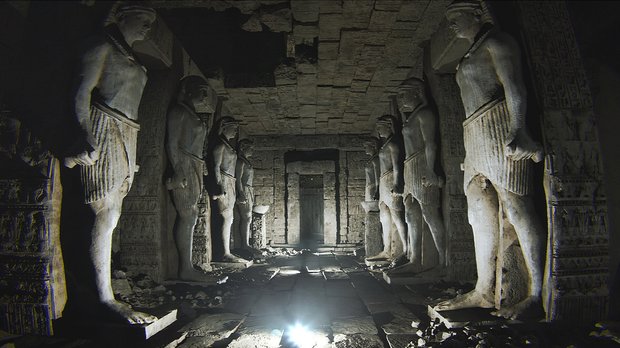
There is no specific indication as to where this device should be used, however. I found myself many times clicking the right mouse button, to no avail. On the other hand, there were some instances when taking a picture elicited another jump scare. Without giving too much away, there’s one puzzle that can only be solved by photographing a clue hidden right in the same room. As the game progressed, a general rule of thumb emerged: if an object or location stands out or seems odd, take its picture, preferably from several different angles. It's not foolproof, but it sure helped me along the way.
Amenti’s puzzles range from easy to moderately challenging—nothing too brain-racking. That said, I took serious issue with the excessive pixel hunting. There is quite a bit of it. The cursor does not help much either; it changes from a tiny dot to a tiny circle (about 2mm in diameter) when an interaction is possible, but there’s no indication of hotspots, nor can they be highlighted. This becomes a major drawback, especially given the setting.
The entire game plays out in a sprawling, dimly lit maze—as one might expect from an ancient Egyptian tomb. The first and final sections are especially dark, with only starlight and Carter’s torch for illumination, while the midsection’s candles and ritual flames still leave many shadowy corners. And there lies an inner maze, which Carter must navigate to retrieve an item critical to his escape. Wandering these claustrophobic corridors can be disorienting, and there is no in-game map to help you find your way. I didn’t find the maze was as large as it initially seemed, and getting completely lost isn’t really possible—but still, a map would have been welcome, especially toward the end.
There is one puzzle that will result in your death if you don’t solve it right. Another instance where you can die is during the game’s climax. Carter must run for his life through a timed maze filled with menacing supernatural entities, all set on either killing him or devouring him altogether. They appear from every direction and move very quickly. Fortunately if you fail to escape, the game revives you at an earlier point shortly before that, allowing you to try again.
Amenti uses an autosave system, with no manual save option in the menu. However, there are “load” and “continue” options. The former loads the last autosave; the latter resumes very close to where you left off. Unfortunately, the checkpoints are too far apart. Though the game is short, I didn’t finish it in one sitting so I had to replay certain sequences multiple times, which became frustrating.
Final Verdict
Despite some shortcomings, Amenti is an enjoyable ride overall. It does not reinvent the wheel or push any boundaries, but what it does, it does well. The game includes all the core ingredients of a solid, immersive experience: an intriguing location and excellent graphics, wrapped in a haunting atmosphere with tight pacing, and a few well-timed jump scares. Think of it like an old-school B-movie: a little cheesy, a little clunky, and not demanding a lot from you, but ultimately entertaining and about the same length. Amenti is not perfect, but for novice players, or experienced ones in search of a shorter, more casual experience, it is worth a look.
Hot take
Although it doesn’t break new ground and isn’t always as user friendly as it should be, Amenti is a well-crafted exploratory horror experience that delivers solid thrills and enjoyable gameplay.
Pros
- Vivid, authentically detailed graphics
- Logical, well-integrated puzzles that are not too difficult
- True sense of exploring an ancient archaeological site
- Creepy atmosphere with some nice jump scares
Cons
- Game is one big maze with no map or hotspot highlighter, lots of scavenger hunting and an infrequent autosave
- Thin plot with no backstory or character development
- Very short
Eran played his own copy of Amenti on PC.

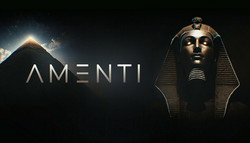








0 Comments
Want to join the discussion? Leave a comment as guest, sign in or register.
Leave a comment